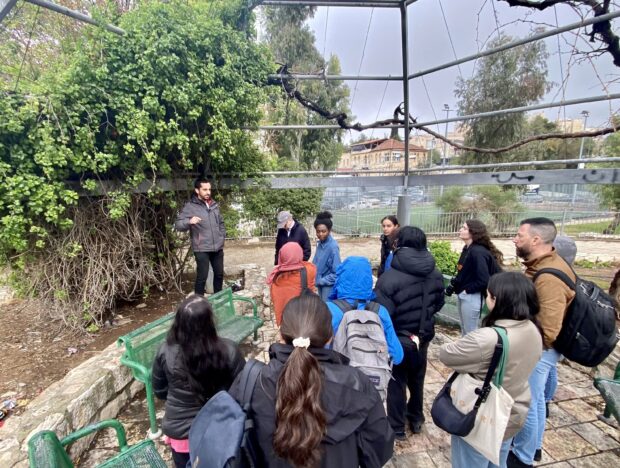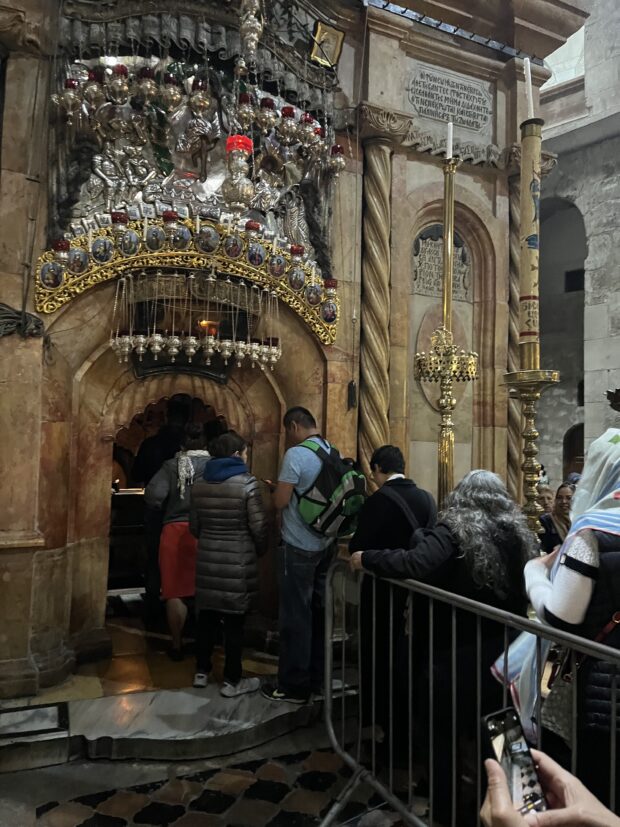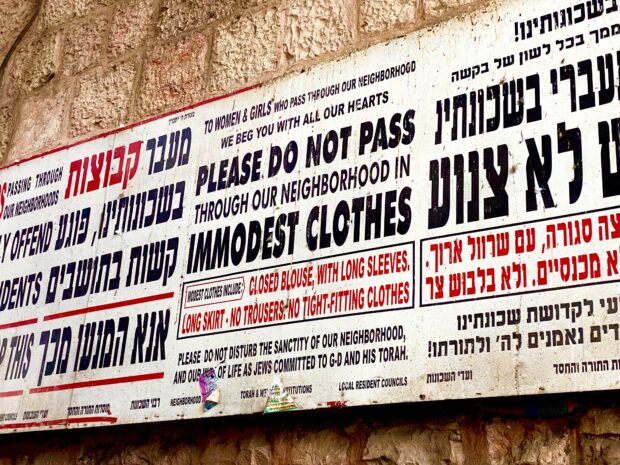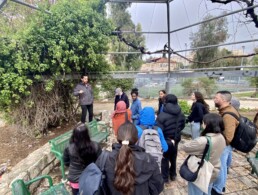Day 4: Rain on the Stones of Jerusalem: On the Ground in the Old City
The early-morning sun reflected off the rows of white houses of Bethlehem as we started the day. Storm clouds started to roll in as we packed into our blue bus that we’re affectionately calling Lilian.
As we started the journey towards Jerusalem, rain began to fall. There was a palpable energy from yesterday’s interviews with settlers Sarah Tesler and Kally Kislowicz. Both Professor Goldman and Adjunct Professor Greg Khalil took turns addressing that conversation as we passed through the checkpoint approaching Jerusalem.
At the American Colony Hotel, we met with our first speakers of the day, Palestinian journalist Dalia Hatuqa, based in Ramallah and focused on the Middle East, and Jalal Abukhater, a 28-year-old Jerusalem resident.
Hatuqa was quick to point out that she is not Israeli and is only allowed into Jerusalem on a permit. The conversation focused on the measures Palestinian residents of Jerusalem have to take to maintain their status as residents in the city, and controversial laws that the Israeli government often uses to force property transfers from Palestinian to Jewish residents. Non-Israeli Jerusalemites must show that their “center of life” remains in Jerusalem; this process can involve such measures as keeping food in the refrigerator in case of unexpected check-ins by authorities. This policy greatly complicates the lives of those who may have a partner or children in the West Bank, since it is difficult for those people to move into Jerusalem.
When the focus switched to what it is like living in Jerusalem, Hatuqa turned the conversation over to Abukhater. We embarked on a walking tour of the traditionally Muslim Sheikh Jarrah neighborhood. Abukhater explained the Absentees’ Property Law, which transfers property to the state in cases where the government deems there is an absentee owner — usually in cases where the original owners fled during the 1948 war. Abukhater showed us the El Kurd home that was presented as an example of forced property transfer in a recent documentary, My Neighbourhood, by Julia Bacha.

We then walked to the Jaffa Gate of the Old City, where we met Walid Zahran for a tour through the narrow, winding alleys of the one-kilometer-square city that holds more than 200 historical monuments and religious sites significant to Muslims, Christians and Jews. Walid, a native and lifelong resident of the Old City, began his talk describing the history of the city’s walls built by Ottoman ruler Suleiman the Magnificent.
In the pouring rain, we entered the city and made our way to the Church of the Holy Sepulchre. The church was constructed on the Golgotha Mont, where Jesus was crucified.
At the entrance, pilgrims kneeled to kiss the marble slab at the place where Jesus’s body was laid. Dozens waited in line to see his tomb; one woman was so overcome with emotion that she started crying. In a corner, a group of people lowered their voices to pray while lighting candles.

At lunch, Goldman returned to the conversation with the settlers that had started on the bus, explaining his own ties to the country. “I have 100 cousins” in Israel, he said, much like Khalil, who has family living in both the West Bank and the Gaza Strip. Goldman used a metaphor borrowed from Pulitzer Prize–winning writer Isabel Wilkerson to describe the state of affairs in Israel and Palestine:
A country is like a house, he said, whose imperfections are the product of all its inhabitants. The condition of the house can’t be blamed on any single inhabitant, but that all of those who live in it have responsibility for what goes on there. Goldman connected this with the class’s response to yesterday’s conversation with two settlers, which elicited strong feelings. He urged the class not to blame any one actor for the larger conflict.
Khalil used the same metaphor but pointed out that his family — and that Palestinians in general — occupy a far less powerful position in that house, and that responsibility for fixing its problems is not shared equally. He urged the class to think about the role of power, and the baggage that comes with being in a less-powerful position. Khalil noted that in many situations, Palestinians and those with less power shoulder much of the burden of advocating for their rights, and highlighted the toll this takes and the physical risk it entails. He urged the class to reflect on why we assume that those who are oppressed must be the only ones to speak up for their communities.
The conversation brought into sharp focus the complexity and emotionally charged nature of the conflict, highlighting the way decades-old disputes that many of us had only read about affect the lives of real people.
We left the marketplace through the Damascus Gate to meet with Anshel Pfeffer, a journalist with Haaretz, who took us for a two-hour walk in Jerusalem’s Mea Shearim neighborhood, where Ultra-Orthodox Holocaust survivors settled after World War II. Over the years, the area expanded and is now home to a wide range of Jewish communities. On one street, men wear shtreimels, and large fur hats; women dress modestly. Smartphones are prohibited, in favor of kosher phones with no internet access.

“This is not a tourism neighborhood,” a young man yelled to us in Hebrew while we walked toward Beit Yisrael, an adjacent Ultra-Orthodox neighborhood. We stopped at Shabbat Square, a busy area during the week that is now closed to traffic on Shabbat after residents protested for a strict observance of the holy day. This visit pushed us to reflect on the dissensions and differences between secular and religious Jews in the country.
We ended the day amid the colorful stalls of the Mahane Yehuda market before heading back to the bus, happy to relax after this day in the rain. We climbed aboard wet and tired, and returned to Bethlehem. There was a consensus in the group for how lucky we are to be able to visit these places and talk with those who live here. We are led by a Columbia professor of 20 years, a self-proclaimed Zionist and writer for the New York Times alongside a successful entrepreneur, Yale Law School graduate and advisor for the Palestinian negotiations. These two individuals coming together despite all that might put them in opposition to show us a sliver of the land at the heart of civilization and religion. As the reality sank in of what could only be described as a life-changing trip, the clouds cleared and gave way to a beautiful orange sunset.

